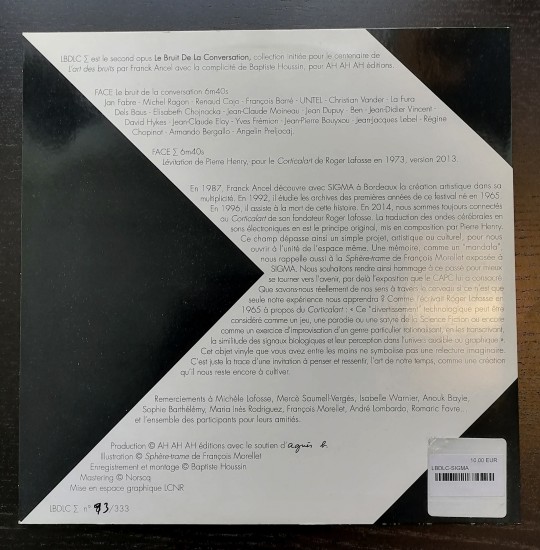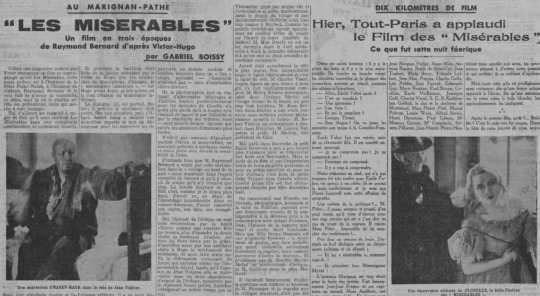#jean-henri fabre
Explore tagged Tumblr posts
Text
« Rude besogne que cette exhumation à coups de tête fendue et palpitante. En outre, l'exténuant effort s'impose au moment de la plus grande faiblesse, lorsque l'insecte sort de sa pupe, coffret protecteur. Il en sort pâle, sans consistance, disgracieux, à peine vêtu des ailes qui, plissées en long et raccourcies par une échancrure sinueuse, couvrent pauvrement le haut de l'échine. Hirsute de cils farouches et coloré de cendré, il a piteux aspect. La grand voilure, apte à l'essor, s'étalera plus tard. Pour le moment elle serait un embarras au niveau des obstacles à traverser. Viendra plus tard aussi le costume correct où la sévérité du noir fait ressortir le bleu chatoyant de l'indigo. »
—Jean-Henri Fabre, Souvenirs entomologiques, 1879
1 note
·
View note
Text
See the extravagant appendage to [the Weevil's] little head. It is here a short, thick snout; there a sturdy beak, round or cut four-square; elsewhere a foolish reed, thin as a hair, long as the body and longer. At the tip of this egregious instrument, in the terminal mouth, are the fine shears of the mandibles; on either side, the antennæ, with their first joints fitting into a groove. What is the use of this beak, this snout, this caricature of a nose? Where did the insect find the model for it? Nowhere. The Weevil invented it and retains the monopoly. Outside his family, no Beetle indulges in these nasal eccentricities. […] Though the Weevil be but little glorified by his talents, this is no reason for despising him. As we learn from the lacustrian schists, he was in the van of the insects with the armoured wing-cases; he was long stages ahead of those which were working out new forms within the limits of the possible. He speaks to us of primitive shapes, sometimes so quaint; he is in his own little world what the bird with the toothed mandibles and the saurian with the horned eyebrows are in a higher world. Jean-Henri Fabre, The Life of the Weevil

#have i done this one before? if so oh well#jean-henri fabre#the life of the weevil#public domain books
38K notes
·
View notes
Text













I recently, in collaboration with my source, archived their collection of Yoshikazu Yasuhiko (安彦 良和)'s concept art for the cancelled 1990s Sunrise adaptation of Fabre's Book of Insects. To view the archives as well as some history on their background, visit below!
Website backup - https://t.co/9sjYoKkMBP
MEGA - https://t.co/bCGWGWCQZf
Internet Archive -https://t.co/FLOwznWKfD
History:
I was graciously allowed to document, clean and archive these illustrations created by Yoshikazu Yasuhiko during the early to mid 1990s by their original owner. I have been in conversation with the owner on Twitter for over two years now after they sent an open request to the community to identify the nature of these works and to help them locate any and all information about them. After touching base, we began our conversations, though the trail often ran cold.
To this date, the current definitive information on these pieces is as follows: Yoshikazu Yasuhiko, while still employed actively by Sunrise's animation department in the early 1990s, created these pieces for an internally held contest to decide who would be in charge of character design for Sunrise's adaptation of Jean Henri Fabre's eponymous text. The dates of the contest are not known, though based on the illustration quality, I can personally say that these are very indicative of Yasuhiko's early 1990s hand and manner of rendering. This would place them in a window between 1990 to 1995 before he made a genuine departure from animation to focus on his work with manga.
Yasuhiko's animation credits, while ending in the early 1990s with F91 Gundam, did not totally cease. The 1990s proved to be a unique time in which Yasuhiko took major forays into character design work for titles such as Super Atragon, Assault Suits Valken II, and Chikyū SOS Soreike Kororin. However, the proposal for Fabre never took off and it became a phantom work, never to see the light of day again until my source was given these items.
These are pencil and watercolor/gouache renderings of the original character designs for not only the protagonist Fabre, but an additional 13 other characters drafted. Each drawing measures 25 cm in height and 20 cm in width (9 x 7 inches), and the character names and their related roles are glued on from clippings made in a word processor. under the character drawings. In addition, since all the characters are numbered from 1 to 13, it is believed that Each drawing is very careful and detailed, and Yasuhiko's specialty full-color watercolor technique and character creation can be seen on each item. These are believed to be the entirety of the lineup as each one is numbered 1-13.
Yoshikazu Yasuhiko himself mentioned the animation of Fabre's Book of Insects in his lecture "Anime and Gundam in the 1970s" held at Hiroshima City University on August 3, 2008. Its existence is also known by his official biographer and interviewer Makoto Ishii. I, too, knew of their existence though only though asking Makoto via Twitter alongside my source, who was told in turn that these works were forgotten by Yasuhiko as well. However, since these works disappeared at the planning stage, they were never mentioned in any books such as "The Complete Works of Yoshikazu Yasuhiko" or "My Back Pages".
Since there are basically no materials left for the anime since it was canceled at the early planning stage, these works haven't seen the public eye. These pieces were preserved in museum glass and carefully stored for years and were photographed by me. I edited them to match their true color and dimensions as I don't have them physically on hand (they are now going to auction in commemoration of the opening of the "Yasuhiko Yoshikazu, the Artist" exhibition in Hyogo).
#yoshikazu yasuhiko#illustration#found media#lost media#concept art#fabre's book of insects#jean henri fabre
16 notes
·
View notes
Text




V/A "Le Bruit de la Conversation" // Pierre HENRY "Lévitation, pour le Corticalart de Roger Lafosse en 1973, Version 2013"
(split 10". Ah Ah Ah Éditions. 2014) [FR]
#pierre henry#2013#electronic#spoken word#performance#art#ben vautier#christian vander#david hykes#jan fabre#jean dupuy#jean claude eloy#jean jacques lebel#jean pierre bouyxou#yves fremion#compilation#10“s#records
5 notes
·
View notes
Text
some things the main characters of Crimson Peak like, according to their official character bios
Lucille
Dark chocolate
The smell of pipe tobacco
Fine leather gloves
Sunlight on her skin in winter
Dinner parties (that one surprised me)
Jean-Henri Fabre's entomology texts
Thomas
Roses
Religious effigies
The smell of shoe polish
Rodin's sculptures
Chestnuts
Travelling the world
Edith
French fries
The smell of tar
Combing her hair
Staying up late
Feather pillows
Byron's poetry
#crimson peak#edith cushing#lucille sharpe#thomas sharpe#argh dictation typo’d ‘entomology’ and I didn’t notice for a few hours
119 notes
·
View notes
Text


Comoedia, 5 February 1934 (note the picture of Harry Baur by the masthead!) So I learned that the 1934 Les Mis film premiered two nights before a far-right anti-government riot! And you can feel that there was a crisis about to happen in this account of the movie's premiere:
A rough start to the night: there’s the taxi driver’s strike and there’s the parliamentary crisis. The latest information passed from mouth to mouth and most journalists arrived late, bearing the most recent news. “So Emile Fabre is jumping ship?” [Fabre was the director of the Comédie-Française and was apparently being pressured to leave.] “It’s a scandal!” “It’s disgraceful!” “What folly!” “And who is replacing him?” “George Thomé.” [Thomé was a musician as well as the former director the Sûreté.] “Seriously?! They’re going to be cuffing the Comedie-Francaise.” Emile Fabre makes his entrance, followed by his charming daughter. He is just as soon surrounded and interrogated. “I don’t understand! I don’t understand!” “No one understands.” “There is too much to understand.” Our editor-in-chief, who has not always been fond of Emile Fabre, is spotted by his side; he shakes his hand cordially and I note that Pierre Lazareff [editor-in-chief of Paris-Soir] notes this effusive sympathy. A political star enters!...M. [François] Piétri [briefly the Minister of Finance]…thoughtfully and hurriedly, he passes by on swift feet which recently exercised a wise retreat that was, if I dare say, a step ahead of wisdom. He joins Mme. Piétri….It’s impossible to get him to open up!... Caught up in the commotion of the crowd, I hear this brief dialog between a political columnist and a deputy: “And how are your ‘misérables’ doing?” “They are waiting for their Monseigneur Myriel!” The huge Marignan theater is too cramped for this crowd of guests. Luckily Jean-José Frappa and his second in command, Mme. Audibert, thought of everything, took care of everything… And everyone is able to get to the coat check and find his place easily. Because the taxi strike and political events delayed hundreds of people, who then arrived all at once and with haste, this was not an easy task. Who was there? Tout-Paris...I randomly noted with my pencil: Messueirs Paul Abram, Achard, De Adler, Berneuil, Archimbaud, André Aron, Arnaud, Louis Aubert, Aubin, Kujay, Kertée, Azaïs, Bacré, Barthe, Baschet, Baudelocque, Harry-Baur, Bavelier, Robert de Beauplan, Antonin Bédier, Pierre Benoit, Mme Spinelly, Charles Delac and Marcel Vandal, Léon Benoit-Deutsch, André Lang, René Lehmann, Bellanger, Mag Bernard, Tristan Bernard, Jean-Jacques Bernard, Louis Bernard, Dr. Etiënne Bernard (all the Bernards!)...Bernheim, Bernier, Guilaume Besnard, Bétove, Bizet, Blumsteien, Mme Rocher, Boesflug, Pierre de la Boissière, Bollaert, Bouan, Boucher, Robert Bos, Pierre Bost, Paul Brach, Henry Roussell, Charles Burguet, Pierre Brisson, Simone Cerdan, Henry Clerc, Albert Clemenceau, Pière Colombier, Germaine Dulac,Henri Diamant-Berger, Julien Duvivier,Jean Epstein, Fernand Gregh, Mary Glory, René Heribel, Tania Fédor, Alice Field, Jacqueline Francell, Mary Marquet, Florelle, Marguerite Moreno, Françoise Rosay, Becq de Fouquière, Jean Servais, Vidalin, Maria Vaisamaki, Orane Demazis, Rachel Deviry, Rosine Deréan, Jacques Deval, Christiane Delyne, Renée Devillers, Jean Chataigner, Germaine Dermoz, Léon Voltera, Robert Trébor, our director, Jean Laffray, Lucie Derain, Paul Gordeaux, Jean Narguet, Parlay, Suzet Maïs, Antoine Rasimi, Renée de Saint-Cyr, Jean Toulout, Mady Berry, Yolande Laffont, Jean Max, Parysis, Charles Gallo, Léo Poldès, Jean Fayard, Edmonde Guy, Mario Roustan, Paul Strauss, Cavillon, Emile Vuillermoz, Josselyne Ga��l, Charles Vanel, S. E. Si Kaddour ben Gabhrit, the duke and duchess of Mortemart, Madame Henry Paté, Marcel Prévost, Louise Weiss, Alfred Savoir, Henri Duvernois, Paul Gémon, magistrate Maurice Garçon, magistrate Campinchi, Sylvette Fillâcier, Jean Heuzé, Pierre, Heuzé, Mona Goya, Simon-Cerf, W.E. Hœndeler, Georges Midlarsky, Michel, Nadine Picard….and others I must be forgetting…pardon me!....Silence!....
In the glow of the half-light from the screen….there are applause! Not since les Croix de bois has a movie been so highly anticipated and now it is time for the verdict….Raymond Bernard can be sure that the audience is rooting for him. Our eyes are full with light and pretty colors. This Paris night is practically magical…and departing from that magic, we are plunged into the great river of les Misérables, into the furious waters of this social storm. Luckily André Lang and Raymond Bernard have made the trip for us. What contrast! From the spectacle of an elegant and distinguished gathering, we move to the misfortunes of Jean Valjean.
The audience picks up on everything that could be an allusion to the present times. But of all these allusions, one stands out. It’s the lament of two gossips, at the moment when the barricades are rising. “What sad times!” “We’ve barely made it through the cholera…and here is the Republic!” Thunderous applause and mad laughter. When, on the barricades, the Republic calls on us to act, the spectators think of other promised actions which haven’t happened and they forget to applaud. But the whole audience is prodigiously virtuous; whenever a good deed is shown on the screen, when some sentence about the heart graces the white canvas, it is punctuated by applause. After the first film, stop!... Time to eat! There’s a mad dash to the punchbowl. In the haste of this day of crisis and running late, many in the audience did not have time for dinner….the buffet, in the blink of an eye, is emptied and the dry drinks make vindictive and impassioned discussions flow. High and low, here and there, everyone was speaking of the Parliment's chances and the intermission bell sounds in an atmosphere charged with electricity. The two other parts of the film, cut by another intermission, each end with a double ovation for Harry Baur, both in the lobby and in the theater. The little Gaby Triquet is passed from person to person towards a chocolate eclair, which she leaves a trace of on the cheeks of Harry Baur. And then as usual everyone rushes to the coat check. Then we go to the fifth floor of the Marignan building. There, in an unoccupied apartment, dinner waits for us. There are more than a thousand of us around little eight-person tables. Ten thousand meters of film, that will make you hungry! Three orchestras pour out waltzes, tangos, and other tunes, while the masters of the hotel fill up our cups. And that continued to six thirty in the morning, in an atmosphere of charming cordiality as each person attested to the pleasure of seeing French cinema accomplish such a feat. Bernard Natan and Raymond Bernard were too surrounded for me to speak to them. Besides, what could I say to them that they haven’t already heard ten times, a hundred times, a thousand times that evening, which was the apotheosis of cinema and of Les Misérables. -Jean-Pierre Liausu
#les miserables#lm 1934#me trying to learn about the 1934 political situation in France via wikipedia
4 notes
·
View notes
Photo

Line Noro and Jean Gabin in Pépé le Moko (Julien Duvivier, 1937)
Cast: Jean Gabin, Gabriel Gabrio, Mireille Balin, Saturnin Fabre, Fernand Charpin, Lucas Gridoux, Gilbert Gil, Marcel Dalio, Gaston Modot, LIne Noro. Screenplay: Henri La Barthe, Julien Duvivier, Jacques Constant, Henri Jeanson. Cinematography: Marc Fossard, Jules Kruger. Production design: Jacques Krauss. Film editing: Marguerite Beaugé. Music: Vincent Scotto, Mohamed Ygerbuchen.
When Walter Wanger decided to remake Pépé le Moko in 1938 as Algiers (John Cromwell), he tried to buy up all the existing copies of the French film and destroy them. Fortunately, he didn't succeed, but it's easy to see why he made the effort: As fine an actor as Charles Boyer was, he could never capture the combination of thuggishness and charm that Jean Gabin displays in the role of Pépé, a thief living in the labyrinth of the Casbah in Algiers. It's one of the definitive film performances, an inspiration for, among many others, Humphrey Bogart's Rick in Casablanca (Michael Curtiz, 1943). The story, based on a novel by Henri La Barthe, who collaborated with Duvivier on the screenplay, is pure romantic hokum, but done with the kind of commitment on the part of everyone involved that raises hokum to the level of art. Gabin makes us believe that Pépé would give up the security of a life where the flics can't touch him, all out of love for the chic Gaby (Mireille Balin), the mistress of a wealthy man vacationing in Algiers. He is also drawn out of his hiding place in the Casbah by a nostalgia for Paris, which Gaby elicits from him in a memorable scene in which they recall the places they once knew. Gabin and Balin are surrounded by a marvelous supporting cast of thieves and spies and informers, including Line Noro as Pépé's Algerian mistress, Inès, and the invaluable Marcel Dalio as L'Arbi.
7 notes
·
View notes
Photo



(A friendly baby) Stag Beetle, in the Parisian suburbs.
Fact from wild life in France: Most people I speak to seem to be at least a little bit fascinated by these spectacular creatures, particularly the males which have the large antler like mandibles and although these look rather threatening it is the female which is about half the size of the male and lacks the antlers who is more likely to give you a bit of a pinch if you pick her up; she is equipped with very powerful and sharp mandibles like clippers. Should you need to move one out of harms way, from a road, a path or even from your house, it is best to nudge them from behind into a tin, plastic container or simply on to your hand and tip them out under a bush or by a tree, making sure that they don’t end up on their back. In most of the regions of France the Stag Beetle and the Lesser Stag beetle are doing reasonably well compared to many other insects, although overall in Europe they have declined and are now scarce in many parts of their previous range. Jean Henri Fabre, 1823–1915, French entomologist and author, reported that he easily filled a top hat with Stag beetles in one evening, which is unimaginable now even if you took a month where they are plentiful.
3 notes
·
View notes
Text
« Le réactif cause de cette liquéfaction échappe à mon examen. Les vers doivent le dégorger par doses infinitésimales, tandis que leurs bâtonnets gutturaux, en mouvement continuel, émergent un peu de la bouche, rentrent, reparaissent. Ces coups de piston, ces sortes de baisers s'accompagnent de l'émission du solvant ; du moins je me le figure ainsi. L'asticot crache sur sa nourriture, il y dépose de quoi la convertir en bouillon. Évaluer en quantité cette expectoration n'est pas dans mes moyens ; je constate le résultat, je n'aperçois pas l'agent provocateur. »
—Jean-Henri Fabre, Souvenirs entomologiques, 1879
0 notes
Text
Events 3.28 (before 1940)
AD 37 – Roman emperor Caligula accepts the titles of the Principate, bestowed on him by the Senate. 193 – After assassinating the Roman Emperor Pertinax, his Praetorian Guards auction off the throne to Didius Julianus. 364 – Roman Emperor Valentinian I appoints his brother Flavius Valens co-emperor. 1065 – The Great German Pilgrimage, which had been under attack by Bedouin bandits for three days, is rescued by the Fatimid governor of Ramla. 1566 – The foundation stone of Valletta, Malta's capital city, is laid by Jean Parisot de Valette, Grand Master of the Sovereign Military Order of Malta. 1745 – War of the Austrian Succession: In the Battle of Vilshofen, Austrian forces defeat French forces. 1776 – Juan Bautista de Anza finds the site for the Presidio of San Francisco. 1795 – Partitions of Poland: The Duchy of Courland and Semigallia, a northern fief of the Polish–Lithuanian Commonwealth, ceases to exist and becomes part of Imperial Russia. 1801 – Treaty of Florence is signed, ending the war between the French Republic and the Kingdom of Naples. 1802 – Heinrich Wilhelm Matthäus Olbers discovers 2 Pallas, the second asteroid ever to be discovered. 1809 – Peninsular War: France defeats Spain in the Battle of Medellín. 1814 – War of 1812: In the Battle of Valparaíso, two American naval vessels are captured by two Royal Navy vessels. 1842 – First concert of the Vienna Philharmonic Orchestra, conducted by Otto Nicolai. 1854 – Crimean War: France and Britain declare war on Russia. 1860 – First Taranaki War: The Battle of Waireka begins. 1862 – American Civil War: In the Battle of Glorieta Pass, Union forces stop the Confederate invasion of the New Mexico Territory. The battle began on March 26. 1910 – Henri Fabre becomes the first person to fly a seaplane, the Fabre Hydravion, after taking off from water runway Étang le Barre, near Marseille. 1918 – General John J. Pershing, during World War I, cancels 42nd 'Rainbow' Division's orders to Rolampont for further training and diverted it to the occupy the Baccarat sector. Rainbow Division becomes "the first American division to take over an entire sector on its own, which it held longer than any other American division-occupied sector alone for a period of three months". 1918 – Finnish Civil War: On the so-called "Bloody Maundy Thursday of Tampere", the Whites force the Reds to attack the city center, where the city's fiercest battles being fought in Kalevankangas with large casualties on both sides. During the same day, an explosion at the Red headquarters of Tampere kills several commanders. 1920 – Palm Sunday tornado outbreak of 1920 affects the Great Lakes region and Deep South states. 1933 – The Imperial Airways biplane City of Liverpool is believed to be the first airliner lost to sabotage when a passenger sets a fire on board. 1939 – Spanish Civil War: Generalissimo Francisco Franco conquers Madrid after a three-year siege.
0 notes
Text
Ce village occitan attire 75 000 visiteurs par an grâce à ses insectes
See on Scoop.it - Variétés entomologiques
Saint-Léons, commune de l'Aveyron située à 600 mètres d'altitude, dévoile un patrimoine naturel exceptionnel qui a façonné la destinée d'un des plus grands entomologistes français. Ce village de 400 habitants est devenu un lieu de pèlerinage pour les passionnés de sciences naturelles grâce à Jean-Henri Fabre, qui y naquit en 1823. Entre gastronomie traditionnelle et découverte scientifique, Saint-Léons perpétue l'héritage de son illustre enfant à travers un tourisme nature unique en son genre.
par Nathalie Publié le 05/02/2025 à 18h00
0 notes
Text

バートランド・ラッセルの言葉366_画像版 n.2846j (Aug. 16, 2024)
ファーブル(Jean Henri Fabre, 1823-1915.フランスの昆虫学者)は,リーダーの後を追う習性を持つ昆虫の集団について描写している。彼は,それが円形であることを知らないリーダーの昆虫とともに,一群の昆虫を円盤の上に置いた。彼らは円盤の上をぐるぐる回り,ついには疲労で死んでしまった。現代の政治家とその信奉者たちは,これらの昆虫と同等かつ非常に似た愚行を犯している。
Fabre describes a collection of insects which had the habit of following their leader. He placed them on a circular disc which their leader did not know to be circular. They marched round and round until they dropped dead of fatigue. Modern statesmen and their admirers are guilty of equal and very similar folly. 出典: Bertrand Russell: Fact and Fiction, 1961, part VI, chap.1 詳細情報.: https://russell-j.com/cool/57T_PT2-0101.HTM
<寸言> これは政治の世界に限った話ではありません。宗教やスポーツの世界でも同様の現象が時々起こります。ファーブルは昆虫を観察しましたが、 ラッセルは人間を幅広く観察しました。もちろん、ラッセルは自分も観察される対象だということはよく自覚しており、しばしば自分を戯画化し、自分の文章にユーモアを添えました。
0 notes
Text
The Life and Love of the Insect by Jean-Henri Fabre - Table of Links
http://dlvr.it/SpstQf
0 notes
Text
It's actually hilarious how terrible every single aspect of this is. Massive wall of text below the fold.
Philosophy
All of this ancient philosophy. So if you were born after our Lord Jesus Christ the alumni of Thomas Aquinas College will not have heard of you.
Year I is a random jumble of Ancient Greek philosophy that purports to be about logic but obviously fails to include any developments in that field made after the Birth of Christ.
Year II is even more of a joke. Let's spend an entire year learning Aristotle's Physics and De Anima which in a real school would be taught in two weeks. Metaphysics? Never heard of her!
Year III is literally unbelievable. Nikomacheia and Politika would not form one tenth of the material of a real class on Ancient Ethics.
Year IV. Oh here's Metaphysics. And Physics again in case you forgor 💀
Maths
Probably the most incomplete part of the curriculum.
Year I is nothing but Euclid's Elements. You know, something that high schoolers learn in six weeks. Also as someone who has read the Elements I think it's a very bad way to learn geometry. I don't care if it was used to teach it for two millenia (it was), there are better ways to learn it now, you know textbooks written in the second millenium.
Year II is nothing but old astronomy, so more basic geometry. Plato's Timaeus is nonsense, it's just incorrect; doing Almagest, De Revolutionibus, Epitome Astronomiae Copernicanae, and Astronomia Nova is redudant, if only someone had summarised all that. Same can be said for Apollonius' and Archimedes' works on conics (a subject that deserves perhaps one chapter in a moden Freshman mathematics textbook).
In Year III we get to ... analytic geometry and calculus? These are also Freshman and Sophomore topics in a real university. Also what happened to algebra and analysis, the basics of modern mathematics? Nowhere to be seen!
Year IV is the absolute grand slam. Let's learn number theory (Freshman or Sophomore subject) from Dedekind. I don't know what to say. And good luck trying to understand relativity without linear algebra or vector calculus!
Natural Sciences
(I don't know if you've heard but there's more than one now.)
Slightly less incomplete than the maths but still extremely bad. I have a lot to say about this and no doubt I'll miss things.
Year I.
Parts of Animals? Are we in Kindergarten? Jokes aside trying to learn anatomy from Ancient Greeks (Aristotle and Galen) is incredibly stupid. You know they thought that men have more teeth than do women, right?
The rest of the biology part is also bad. Entomology? really? That's the only 'modern' (non-ancient) work on animal biology here? Jean-Henri Fabre's work was not bad for the mid-1850s but the most comprehensive work here is on insects?
De Motu Cordis is historically important for advancing physiology by figuring out the basics of circulation and laying down the foundation of cardiology (the shoulders of the giant at the bottom of the stack) but it's outdated! William Harvey defended people accused of withcraft at witch trials! I learned all the stuff he wrote about circulation and more when I was thirteen years old and I spent most of those classes daydreaming!
Systema Naturae is not about biology per se, it's about classifying organisms which is a kind of a specialised subfield. And while Linné's work was incredibly seminal and important taxonomy has undergone massive changes since. Mendel is fine but again genetics has in fact developed since.
DeKoninck was a weird Catholic philosopher and the only summaries of The Lifeless World of Biology I could find were from weird Catholic schools so I can't imagine it's very good.
Pascal and Archimedes? That ought to take care of the 'Freshman Physics' business. Mechanics? anything??
I don't recognise most of the 'Various Authors' but including Goethe's works on natural science makes me think they're probably not very good.
'Measurements Manual' could be anything but how much do you want to bet they use English customary units?
Year II. 'Atomic Theory' ... this is my wheelhouse but where to even begin?
Let's just ignore Aristotle and Aquinas. Their insights into chemistry are worth a margin note.
Lavoisier was incredibly brilliant and basically invented chemistry. And he did that at a time that, even with hindsight, I can't begin to imagine how you'd do figure out how to start doing chemical research. But again, outdated.
Avogardo, Dalton, Gay-Lussac, Pascal? So basically all of the chemistry and physics on this curriculum is about ideal gases? Stuff you learn in highschool?
Original scientific papers are a very bad way to learn the basics of science. They often have weird archaic notation and always lack further insights.
Year III. So now we get basic mechanics. It's Descartes, Galileo and Newton so get ready for obscure terminology and outdated notation. The Freshman Mechanics class I mostly spent looking at my phone gave me a better understanding of physics than this will give to students who didn't have Freshman and Sophomore classes on calculus. (Before you come at me my grade from Mehcanics I was 3/5 so pretty good.)
Year IV—the trifecta! Like someone on Twitter put it 'Can't talk right now, I need to go to my magnets and evolution class.'
Newton and Huygens did important work on optics but it's outdated.
Come one, Jack, don't try to learn electromagnetism from a book from 1600. I know I sound like a broken record but there's only so many ways I can express this sentiment.
I'd like to see how they teach Faraday and Maxwell to their completely mathematically illiterate students.
The evolution reading list ... oh my God. So it's On the Origin of Species by Darwin and Ernst Mayr's One Long Argument which I haven't read but based on reviews is seems like a good semi-popular synoptic work on evolutionary biology ... and then a bunch of shit desperately trying to convince you they're wrong. Jenkin, and Mivart were outright anti-Darwinists, and while Polanyi and Kass were not (I'm not sure about Kass) the essays seem to be selected to be able to be taught like the Devil would teach the Bible. A bit bad-faith here but I'll indulge myself. And to top it all off there's a bunch of Genesis hodgepodge from the Middle Ages.
Schrödinger's What is Life? was written before DNA was discovered. And while he had an interesting inkling as to how heritable traits are passed onto offspring why not pick a text from after they figured DNA out?! Oh but they added the Watson & Crick paper so it's fine!
The following works are repeated from before: Newton's Principia, Aristotle's Metaphysics, Mendel's 'Experiments in Plant Hybridisation'.
They don't include anything about earth science or modern astronomy (you know, stuff that isn't just about looking at the sky with your bare eyes).
One might also note that et alii would be more correct Latin than et alia since you know all of the people they're etaling are men. I thought such a classics focussed school would care about getting basic Latin right but apparently not.
Language
I don't know about John Nesfield so I'll limit my comments but based on his Wikipedia article he seems to have been against the Indian caste system ... but for the reason that the castes were not sufficiently pure and distinct races to him so make of that whatever thou wilt.
I don't think the Latin readings are very interesting to be quite honest. A few paltry 'selections' from Horace and Cicero form the classical part and a grammar manual and a mass the mediaeval part. Pretty sure my high school classmates who took Latin read more works that were more challenging. And I don't know if New Latin or Contemporary Latin (such as the texts dealing with mundane present-day news written for Nuntii Latini) are generally touched upon while teaching Latin in real schools but you know they're not doing it here.
Music
This is so, so bad as well. The theory is a bunch of crap. If you wanted to learn the basics of music theory from a Great Book of the Western World I would recommend Harmony and Counterpoint (and maybe even Orchestration) by Walter Piston or Harmonielehre by Arnold Schoenberg which are used in real schools as well. I guess even though Harmonielehre concerns itself only with traditional, tonal harmony Schoenberg is anathema is at Thomas Aquinas. You know they have shit takes on 20th century music.
And the music that they've chose, the single set of pieces they're going to study, are the Godforsaken Mozart sonatas. Mozart' least interesting, least innovative, least not-boring, least good works. I'm actually fuming. No interesting melodies, harmonies, rhythms, orchestration, anything at all, just the endless, bland, major-key tinkling of Mozart's potboilers. If you really, really wanted to teach a single set of keyboard pieces, you should have picked the Well-Tempered Clavier by Bach.
Theology
Even though this is a Christian college the theology curriculum is still total ass!
Year I. The Bible, just the read The Bible. That's not how you learn theology.
Year II. Some stuff that'd be covered in four weeks in a Freshman class in a real university.
Years III & IV. Summa Theologiae. Yep, two years on this one work. Now, it is a big boy, old Summa, but college students can learn faster than that.
I don't even care about theology and this is so crap it makes me mad.
Seminar
Last but very unfortunately not least: 'Seminar'. I'm not going to comment on everything because I've already spent too long writing this. Let me just say: this is the most pretentious, wanky, cringe reading list ever. It's just too much.
If you learn history from Ancient historians you're just learning straight up incorrect information.
The classic works of fiction are just so basic.
Why did you put all philosophy after 100 BCE in here?
It's too much.
Funny details:
They included the US Articles of Confederation, Declaration of Independence, Constitution, and the Lincoln-Douglas debates. Just ell oh ell.
The One Single book by a woman is Emma by Jane Austen.
I don't know why but it's extremely funny that the last thing is Marx. Right below Huckleberry Finn as well. Just imagining how they teach Marx is making me go crazy. Also imagine an asshole rich kid going through this clown college before he takes over his dad's job as the CEO of the racism factory encountering Marx for the first time and becoming a communist. Wouldn't that be hilarious? Marx also holds the distinction of being the newest philosopher on the list.
It's just so bad. It's so stupid, I feel dumber just for having read this list.



This is the most deeply unserious shit I have ever seen in my life. $40k/year clown college
15 notes
·
View notes
Photo

4 notes
·
View notes
